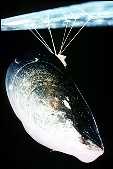
|
 Mussel suspended by byssal fibers |
The
Effect of Species on the
Structure and Strength of Byssal Fibers
in the case of Dreissena Mussels
Katie Fitzgibbons '02
Abstract:
Zebra and quagga mussels, freshwater bivalves of theDreissena genus, are quickly multiplying and spreading throughout many tributaries in the northern United States and Canada. These mussels attach to substrates within the waterways using a network of protein threads called byssal fibers, which are the focus of this study. The goal was to analyze the strength of these byssal fibers when subjected to tensile, shear, and torsional forces. In addition, a comparison of byssal fiber strength between the two different species was conducted. In doing so, the goal was to come up with a physical explanation for the habitat preferences of zebra and quagga mussels. Statistical analysis of the results obtained shows that there seems to be no strong difference in attachment strength based on species. However, correlation tests suggest that a relationship between body mass and force exists for zebra mussels in the shear and tensile cases but does not for quaggas. Further studies analyzing the difference in shell shapes between the two mussel species and the structure of the byssal fibers will supplement this data, giving explanations as to the habitat characteristics and physical limitations of the animals.
For more information, contact:
Dr. Brian Watson (Physics):
or
Dr. Brad Baldwin (Biology):
Return To 2002 Senior Projects
|
|
||
| © | St. Lawrence University | Department of Physics |
| Revised: 25 Jun 2003 | Canton, NY 13617 |